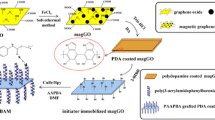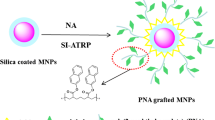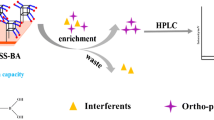Abstract
A boronate-modified magnetic affinity sorbent was prepared by adopting hyperbranched polyethyleneimine as the scaffold to amplify initiator sites. 3-Acrylamidophenylboronic acid was employed as monomer to proceed in situ free-radical polymerization on magnetite (Fe3O4) nanoparticles. Due to the improved density of boronic acid polymers, the adsorbent exhibited high adsorption capacity, typically (134 ± 8) μg mg−1 for dopamine, (92 ± 7) μg mg−1 for catechol, (363 ± 14) μg mg−1 for ovalbumin and (464 ± 22) μg mg−1 for horseradish peroxidase. These capacities are much higher than those of other adsorbents. The sorbent was applied to the enrichment of catecholamines from spiked human urine. Owing to the high adsorption capacity, only 1.0 mg of adsorbent was sufficient to eliminate the interferences and enrich the targets (dopamine, norepinephrine and epinephrine) within 5 min. They were quantified by HPLC. The recoveries from spiked samples range between 83.5% ~106%, with relative standard deviations of 3.2 ~ 9.4% (n = 5). The separation of glycoproteins from egg white was also accomplished prior to their analysis by PAGE. In the authors’ perception, this approach is promising in that the density of functional groups on the adsorbent is strongly increased.

The preparation routine of boronate affinity magnetic adsorbent (Fe3O4@HpAAPBA). The adsorbent is used for the magnetic solid phase extraction of cis-dol compounds from real sample.







Similar content being viewed by others
References
Veillon L, Fakih C, Abou-El-Hassan H, Kobeissy F, Mechref Y (2018) Glycosylation changes in brain Cancer. ACS Chem Neurosci 9:51–72
Marsico G, Russo L, Quondamatteo F, Pandit A (2018) Glycosylation and integrin regulation in Cancer. Trands Cancer 4:537–552
Mohler LK, Czarnik AW (1993) Ribonucleoside membrane transport by a new class of synthetic carrier. J Am Chem Soc 115:2998–2999
Dosekova E, Filip J, Bertok T, Both P, Kasak P, Tkac J (2017) Nanotechnology in Glycomics: applications in diagnostics, therapy, imaging, and separation processes. Med Res Rev 37:514–626
Ma R-T, Ha W, Chen J, Shi Y-P (2016) Highly dispersed magnetic molecularly imprinted nanoparticles with well-defined thin film for the selective extraction of glycoprotein. J Mater Chem B 4:2620–2627
Zhang S, He X, Chen L, Zhang Y (2014) Boronic acid functionalized magnetic nanoparticles via thiol–ene click chemistry for selective enrichment of glycoproteins. New J Chem 38:4212–4218
Jayeoye TJ, Cheewasedtham W, Putson C, Rujiralai T (2018) Colorimetric determination of sialic acid based on boronic acid-mediated aggregation of gold nanoparticles. Microchim Acta 185:409
Espina-Benitez MB, Randon J, Demesmay C, Dugas V (2017) Development and application of a new in-line coupling of a miniaturized boronate affinity monolithic column with capillary zone electrophoresis for the selective enrichment and analysis of cis-diol-containing compounds. J Chromatogr A 1494:65–76
Yang Q, Huang D, Zhou P (2014) Synthesis of a SiO2/TiO2 hybrid boronate affinity monolithic column for specific capture of glycoproteins under neutral conditions. Analyst 139:987–991
Yang J, He X, Chen L, Zhang Y (2017) Thiol-yne click synthesis of boronic acid functionalized silica nanoparticle-graphene oxide composites for highly selective enrichment of glycoproteins. J Chromatogr A 1513:118–125
Cheng T, Zhang Y, Liu X, Zhang X, Zhang H (2017) A filter paper coated with phenylboronic acid-modified mesoporous silica for enrichment of intracellular nucleosides prior to their quantitation by HPLC. Microchim Acta 184:4007–4013
Cheng T, Zhang Y, Liu X, Zhang X, Zhang H (2017) Surfactant assisted enrichment of nucleosides by using a sorbent consisting of magnetic polysulfone capsules and mesoporous silica nanoparticles modified with phenylboronic acid. Microchim Acta 184:271–278
Hu Y, Xia Q, Huang W, Hou X, Tian M (2017) Boronate-modified hollow molecularly imprinted polymers for selective enrichment of glycosides. Microchim Acta 185:46–54
Cheng T, Jiao Z, Liu X, Zhang H (2018) Selective, fast and semi-automatic enrichment of nucleosides by using a phenylboronic acid modified hybrid material composed of graphene oxide and melamine sponge. Microchim Acta 185:348–353
Deng Y, Gao Q, Ma J, Wang C, Wei Y (2018) Preparation of a boronate affinity material with ultrahigh binding capacity for cis-diols by grafting polymer brush from polydopamine-coated magnetized graphene oxide. Microchim Acta 185:185–196
Jiang L, Messing ME, Ye L (2017) Temperature and pH dual-responsive Core-brush nanocomposite for enrichment of glycoproteins. ACS Appl Mater Interfaces 9:8985–8995
Wang C, Xu H, Wei Y (2016) The preparation of high-capacity boronate affinity adsorbents by surface initiated reversible addition fragmentation chain transfer polymerization for the enrichment of ribonucleosides in serum. Anal Chim Acta 902:115–122
Liu J, Yang K, Shao W, Qu Y, Li S, Wu Q, Zhang L, Zhang Y (2016) Boronic acid-functionalized particles with flexible three-dimensional polymer branch for highly specific recognition of glycoproteins. ACS Appl Mater Interfaces 8:9552–9556
Ma H, Jiang L, Hajizadeh S, Gong H, Lu B, Ye L (2018) Nanoparticle-supported polymer brushes for temperature-regulated glycoprotein separation: investigation of structure–function relationship. J Mater Chem B 6:3770–3781
Wang W, He M, Wang C, Wei Y (2015) Enhanced binding capacity of boronate affinity adsorbent via surface modification of silica by combination of atom transfer radical polymerization and chain-end functionalization for high-efficiency enrichment of cis-diol molecules. Anal Chim Acta 886:66–74
He Y, Huang Y, Jin Y, Liu X, Liu G, Zhao R (2014) Well-defined nanostructured surface-imprinted polymers for highly selective magnetic separation of fluoroquinolones in human urine. ACS Appl Mater Interfaces 6:9634–9642
Yang F, Lin Z, He X, Chen L, Zhang Y (2011) Synthesis and application of a macroporous boronate affinity monolithic column using a metal-organic gel as a porogenic template for the specific capture of glycoproteins. J Chromatogr A 1218:9194–9201
Ouadah A, Luo T, Wang J, Gao S, Wang X, Zhang X, Fang Z, Wu Z, Wang J, Zhu C (2018) Imidazolium-grafted graphene oxide via free radical polymerization: an efficient and simple method for an interpenetrating polymer network as electrolyte membrane. Compos Sci Technol 164:204–213
Li H, Zhang X, Zhang L, Wang X, Kong F, Fan D, Li L, Wang W (2016) Preparation of a boronate affinity silica stationary phase with enhanced binding properties towards cis-diol compounds. J Chromatogr A 1473:90–98
Li N, Chen J, Shi YP (2017) Magnetic polyethyleneimine functionalized reduced graphene oxide as a novel magnetic solid-phase extraction adsorbent for the determination of polar acidic herbicides in rice. Anal Chim Acta 949:23–34
Zhang R, Li Q, Gao Y, Li J, Huang Y, Song C, Zhou W, Ma G, Su Z (2014) Hydrophilic modification gigaporous resins with poly(ethylenimine) for high-throughput proteins ion-exchange chromatography. J Chromatogr A 1343:109–118
Li J, Wang F, Wan H, Liu J, Liu Z, Cheng K, Zou H (2015) Magnetic nanoparticles coated with maltose-functionalized polyethyleneimine for highly efficient enrichment of N-glycopeptides. J Chromatogr A 1425:213–220
Zhang G, Zhang Y, Ji C, McDonald T, Walton J, Groeber EA, Steenwyk RC, Lin Z (2012) Ultra sensitive measurement of endogenous epinephrine and norepinephrine in human plasma by semi-automated SPE-LC-MS/MS. J Chromatogr B 895-896:186–190
Du J, He M, Wang X, Fan H, Wei Y (2014) Facile preparation of boronic acid-functionalized magnetic nanoparticles with a high capacity and their use in the enrichment of cis-diol-containing compounds from plasma. Biomed Chromatogr 29:312–320
Li D, Xia H, Wang L (2018) Branched polyethyleneimine-assisted boronic acid-functionalized silica nanoparticles for the selective enrichment of trace glycoproteins. Talanta 184:235–243
Li D, Bie Z (2017) Branched polyethyleneimine-assisted boronic acid-functionalized magnetic nanoparticles for the selective enrichment of trace glycoproteins. Analyst 142:4494–4502
Qin Q, Li H, Shi X, Xu G (2015) Facile synthesis of Fe3O4@polyethyleneimine modified with 4-formylphenylboronic acid for the highly selective extraction of major catecholamines from human urine. J Sep Sci 38:2857–2864
Wang J, He X, Chen L, Zhang Y (2016) Boronic acid functionalized magnetic nanoparticles synthesized by atom transfer radical polymerization and their application for selective enrichment of glycoproteins. RSC Adv 6:47055–47061
Li Q, Lü C, Li H, Liu Y, Wang H, Wang X, Liu Z (2012) Preparation of organic-silica hybrid boronate affinity monolithic column for the specific capture and separation of cis-diol containing compounds. J Chromatogr A 1256:114–120
Zhang X, He X, Chen L, Zhang Y (2014) A combination of distillation–precipitation polymerization and click chemistry: fabrication of boronic acid functionalized Fe3O4 hybrid composites for enrichment of glycoproteins. J Mater Chem B 2:3254–3262
Acknowledgements
This work was supported by the National Natural Science Foundation Supporting Program of Xi’an Medical University (No.2017GJFU08), National Natural Science Foundation of China (No. 81702010), Natural Science Basic Research funded by Shaanxi Provincial Science and Technology Department (No. 2018JQ8051) and Natural Science Foundation of Shaanxi Provincial Department of Education (No. 18JK0655 and 18JK0664).
Author information
Authors and Affiliations
Corresponding author
Ethics declarations
Conflict of interest
The authors have declared no conflict of interest.
Additional information
Publisher’s note
Springer Nature remains neutral with regard to jurisdictional claims in published maps and institutional affiliations.
Electronic supplementary material
ESM 1
(DOCX 361 kb)
Rights and permissions
About this article
Cite this article
He, M., Wei, Y., Wang, R. et al. Boronate affinity magnetic nanoparticles with hyperbranched polymer brushes for the adsorption of cis-diol biomolecules. Microchim Acta 186, 683 (2019). https://doi.org/10.1007/s00604-019-3785-y
Received:
Accepted:
Published:
DOI: https://doi.org/10.1007/s00604-019-3785-y




